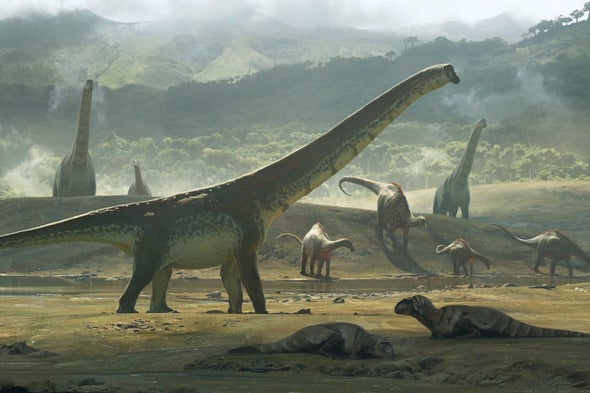Of all the animals ever to have roamed the planet, the iconic long-necked, long-tailed dinosaurs known as sauropods stand unrivaled. No other terrestrial creatures have come close to attaining their colossal sizes. They overshadowed all other dinosaurs, from the duck-billed hadrosaurs and the horned ceratopsians to the armored ankylosaurs and predatory tyrannosaurs. Even the mightiest land mammals—mammoths and rhinoceroslike beasts that were up to twice as heavy as the largest elephants alive today—were featherweights compared with the biggest sauropods.
From an evolutionary perspective, this singularity makes sauropods an intriguing anomaly. Evolution is rampant with examples of convergence, in which the same feature evolves more than once independently in different groups of organisms. A classic example of convergence is powered flight—flapping wings evolved in birds, bats, pterosaurs and insects, but the particular bones or other structures making up the wings differ among the groups, attesting to their independent evolutionary origins. Convergence in evolution is very common even when it comes to complicated features: warm-bloodedness, eyes that can move and focus, bipedal locomotion, the loss of limbs, the use of tools, and live birth all evolved multiple times in different animal groups. Convergence is widespread in the plant kingdom as well: carnivorous plants evolved at least a dozen times, roots evolved more than once, and even arborescence—plants taking the form of trees—evolved more than once. With convergence so common in nature, sauropods' uniqueness in size is special in itself. No other land animal has approached even a third of the largest sauropods' weight. What makes sauropods stand out from the crowd, both literally and figuratively?
Thanks to a wealth of sauropod discoveries over the past few decades, paleontologists are beginning to piece together the answer to this question. Analyses of this burgeoning fossil record reveal where and when these dinosaurs became giants, and the factors that allowed them to evolve extreme sizes again and again over the course of their nearly 150-million-year-long reign. They also suggest that, as mind-bogglingly huge as the largest-known sauropods were, even bigger ones remain to be discovered.
A Growing Fossil Record
Figuring out how sauropods evolved their uniquely enormous sizes has proved challenging because historically they had a relatively terrible fossil record—much worse than that of many other land animals and orders of magnitude worse than that of most animals that live in the sea. The first step in becoming a fossil is burial, and for immense sauropods that would have required an event that could deposit a lot of sediment on the body at once. Think landslides and flash floods, which might take place only a few times a decade or century in a given region, as opposed to the seasonal flooding of smaller streams and rivers that can bury smaller animals multiple times a year. Compounding this problem, landslides and flash floods are violent affairs that scatter the fragile parts of an animal's skeleton. Sauropods had particularly uneven skeletons, combining dense limb bones as thick as tree trunks, vertebrae so riddled with air sacs that they resemble honeycomb, and small skulls composed of sometimes paper-thin bones.

There's a human element holding back the sauropod fossil record as well. A paleontologist can spend a field expedition digging up just a handful of sauropod bones or, in the same amount of time, scout and collect several skeletons of smaller creatures. Likewise, scientists can spend their finite research time in a museum waiting to get a single bone down from a shelf with a forklift or get straight to the business of studying the anatomy of a more sensibly sized animal. With limited time and grant funding, sometimes sauropods are skipped over.
Despite these hindrances, both the sauropod fossil record and our understanding of it have improved greatly over the past few decades. Throughout most of the 20th century, few new sauropods came to light. In the 1990s the situation began to change, as interest in dinosaurs ratcheted up and paleontologists undertook more excavations. Around the turn of the millennium, sauropod discoveries increased quickly. For the past decade researchers have commonly announced around 10 new species each year. With this better sauropod record available, we can finally start to study the evolution of their tremendous sizes.
Tipping the Scale
To figure out why sauropods are so exceptional, we must first understand when, where and how they got that way. Currently there are about 250 sauropod species known from around the globe, and researchers continue to make important discoveries in areas that are relatively unexplored, such as Antarctica, and in areas that have been surveyed for decades, including Australia and North America.
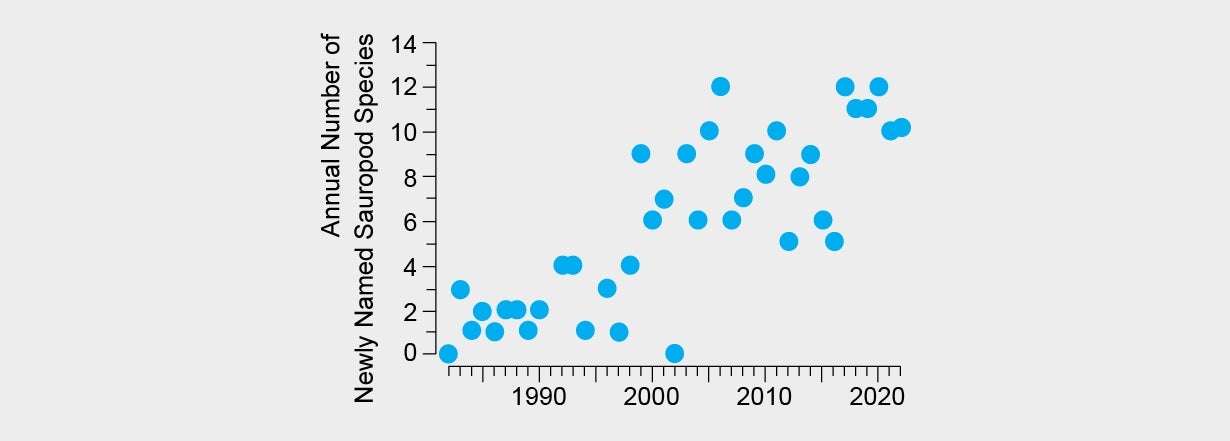
From these new discoveries we know that sauropods' overall body proportions varied quite a bit. Some were slender like giraffes, and others were stocky like elephants. Some had necks that elegantly mirrored their tails, whereas others appeared unsettlingly off-kilter. Some had longer front legs than rear, giving them a stately appearance; others had low-slung shoulders, keeping their necks and heads near the ground. From their footprints we know that some sauropods walked with their legs near the midline like most quadrupeds; others held their legs farther out, like 50-foot-long French bulldogs. This diversity of body forms meant that multiple sauropods could coexist in the same ecosystems, with each species adapted to exploiting different resources within a given setting. We often find more than one sauropod species from a given time and place.
Their diversity of body forms also makes comparing the evolution of body size in terms of length or height tricky, so biologists turn to body mass (or weight) to make more equitable comparisons. Body mass is not just useful for making apples-to-apples comparisons. It also correlates with biologically important features such as metabolic rate, growth rate, nest clutch size, longevity and home range size. In this way, calculating body mass can give us an idea of these features of an extinct animal, so long as we are mindful of how fuzzy or sharp the correlation is.
Several methods exist for estimating body mass in extinct animals. The most popular is based on limb bone dimensions. Think of sauropod limb bones as columns supporting a building. Because the amount of weight supported by a column increases with thickness, we can estimate the mass of a sauropod based on the cross-sectional area of its limb bones. About 200 of the 250 sauropod species on record are known from fossils that include limb bones complete enough to measure this way.
I recently obtained these measurements and used them to chart sauropod body mass evolution. It turns out that over their long history, sauropods evolved a wide range of sizes. The largest include the truly gargantuan, such as the more than 50-metric-ton titanosaur Patagotitan. The smallest, such as the 20-foot-long Magyarosaurus, weighed only as much as a bull. I plotted these species on an evolutionary tree and stretched the tree over time to see when and how many times sauropods increased or decreased their body mass. When they first appeared more than 200 million years ago, they were relatively small—about the size of a rhinoceros. By around 165 million years ago the first giants, non-neosauropods, including the ultralong-necked mamenchisaurids, evolved.
Most sauropods were not exceptional in size compared with the largest terrestrial mammals. Consider Diplodocus, an especially long-tailed sauropod that inhabited western North America around 155 million to 145 million years ago. The Diplodocus specimen known as “Dippy,” replicas of which are exhibited in museums around the world, weighed a paltry 14 tons in life, smaller than the largest mammoths or rhinoceroslike mammals of the past. Dippy's weight is close to the average sauropod body mass. Like Dippy, three fourths of all sauropods weighed less than the largest land mammal.
From this relatively modest stock, I found, sauropods evolved their record sizes a remarkable three dozen times on six landmasses over the course of 100 million years. Sauropods evolved their hallmark sizes early on, and with each new family to evolve, one or more lineages independently reached superlative status. This filling and refilling of the “extremely large body” niche mirrors the pattern seen in land mammals, which evolved very large body sizes quickly in the wake of the dinosaur extinction, before plateauing in the gigantic-mammoth range.
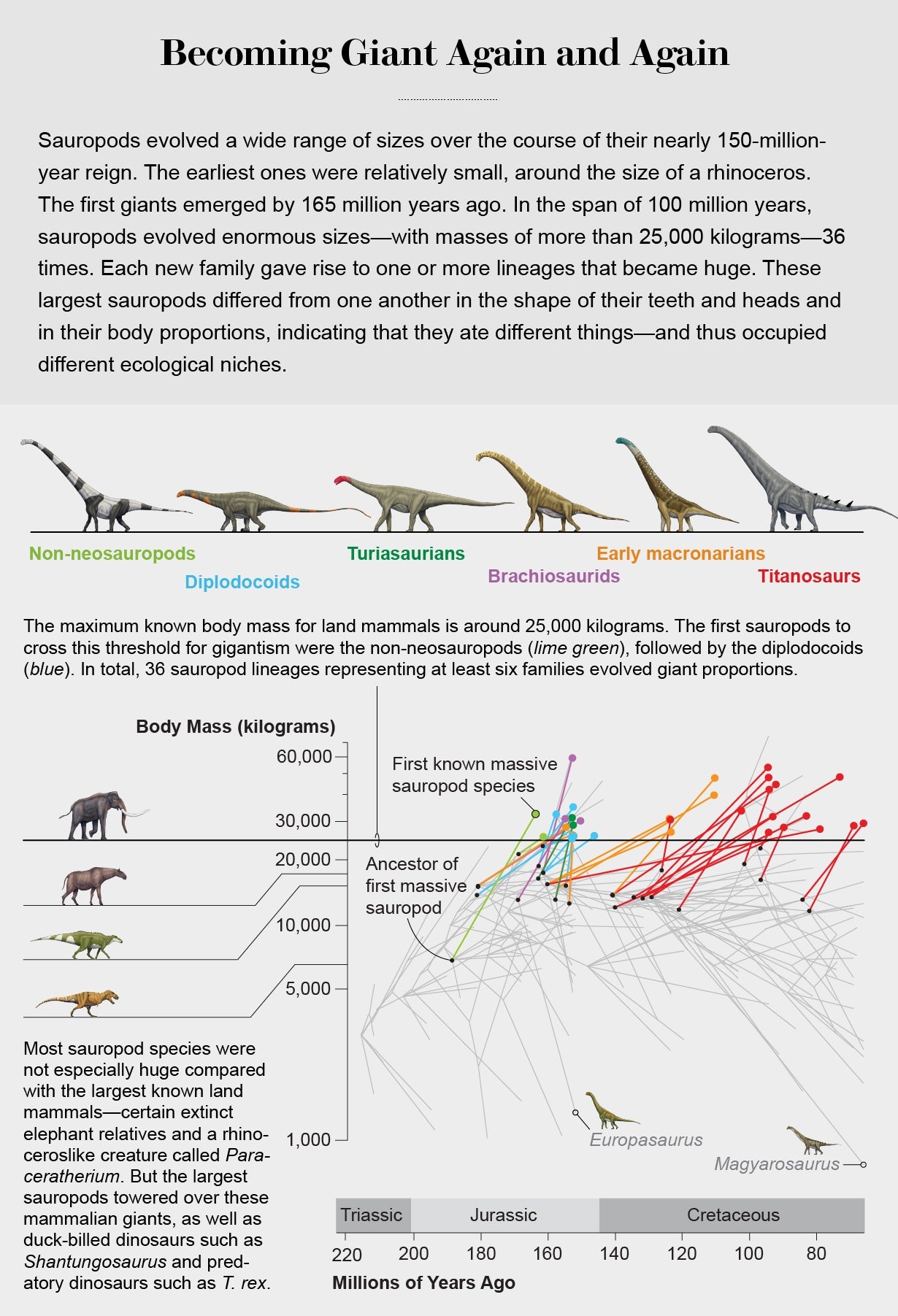
The largest-of-the-large sauropods had differently shaped teeth and heads and distinctively proportioned bodies, indicating that these herbivorous dinosaurs ate different plants and lived in subtly different habitats. In other words, like sauropods in general, the heftiest sauropods occupied somewhat different ecological niches from one another.
The Limits of Evolution
The sheer size of the biggest-known sauropods raises fascinating questions about the limits of evolution: Just how big can animals get on land? And why can't they get bigger than that? Biomechanical studies provide some hints. Mobility decreases as limb bones increase in thickness to support a larger animal's weight, so there is an upper limit to how thick limb bones can be while still supporting a functional animal. From a physics perspective, research by Jyrki Hokkanen of the University of Helsinki suggests that the theoretical limit for terrestrial body mass based on biomechanics is well over 100 metric tons. Over the years, murky reports of a few now-lost fossils have hinted at the existence of sauropods with masses greater than that. But the largest definitive sauropod, the exceptional 75-metric-ton Argentinosaurus, doesn't approach that limit. In addition to biomechanics, factors such as resource and habitat availability and heat dissipation also limit maximum body mass in complex and interacting ways that are difficult to predict. For now all we can say is that terrestrial animals could get at least as big as Argentinosaurus and most likely bigger. It is probably only a matter of time before sauropods larger than Argentinosaurus are discovered.
To reach their record sizes, sauropods underwent record growth. They had the most growing to do of any animal (in an absolute sense), passing through four orders of magnitude in body mass. They had to grow so much not only because their adult body sizes were huge but also because they started out so small. Like other dinosaurs, including modern birds, sauropods hatched from eggs. The larger an egg is, the sturdier the shell needs to be. But evolution can thicken and strengthen eggshell only so much because the shell must allow for gas exchange and the eventual exit of the hatchling. These demands greatly restrict egg size. Sauropod eggs were cantaloupe- to basketball-sized, smaller than those of the biggest birds. Even a 100-foot-long sauropod started out life just a foot or two long. In contrast, placental mammals, which give birth to live offspring, have young that start out relatively large. For example, blue whale calves are around 20 to 25 feet long when they are born, so they must approximately quadruple in length to reach their adult size—a modest task compared to the perhaps 100-fold increase in length set before a hatchling sauropod.
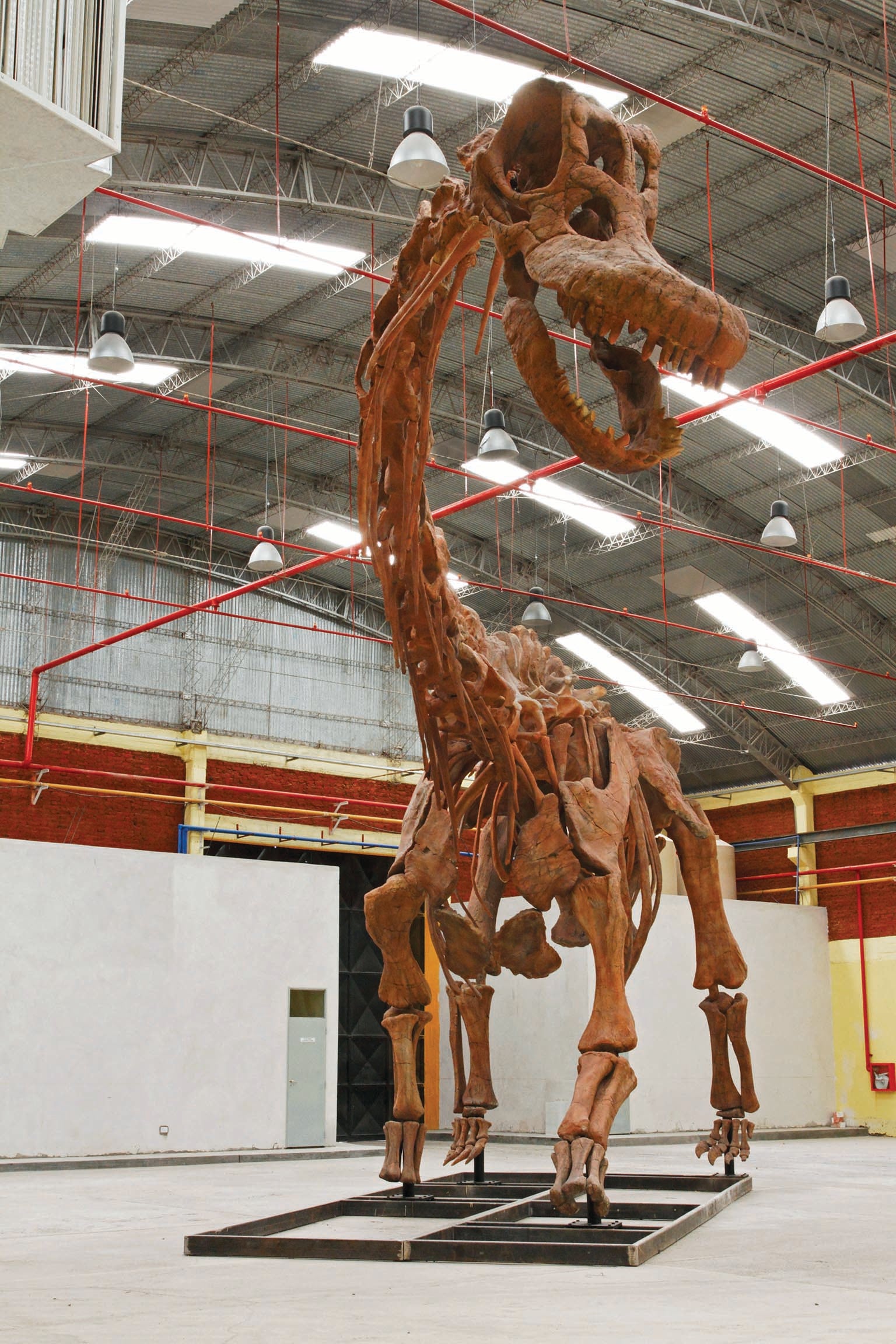
Studies of the bones of several sauropod species have revealed how they accomplished this growth. Just as trees contain rings that can be counted to determine their ages and growth histories, bones contain rings that record a vertebrate animal's age and its rate and duration of growth. Modern-day vertebrates exhibit a variety of growth strategies. Reptiles, including alligators, lizards and turtles, grow relatively slowly, whereas large mammals such as the blue whale grow rapidly. If sauropods grew at the relatively sluggish rates that reptiles do today, it would have taken a century or more for them to reach their immense sizes. Instead, as the growth rings reveal, they grew impressively quickly—on par with the growth rates seen in many large mammals today—attaining adult size in 20 to 50 years.
Sauropods probably needed to grow fast because although adults may have been safe from predators, hatchlings were easy prey that had to compete with other groups of dinosaurs and animals for resources. Unlike large mammals such as whales, which spend years raising each calf, sauropods pursued a quantity-over-quality approach to reproduction, producing lots of eggs and then leaving their young to fend for themselves. Fossils show that at least some groups of sauropods nested in colonies and built their nests quite close together—too close for an adult to pass between—which would have prevented parental care. The faster hatchlings could grow, the better their odds of surviving predators.
That said, sauropod growth rates varied quite a bit from species to species. As sauropods initially evolved larger sizes, they did so by growing faster during annual growth pulses while pausing growth during unfavorable seasons, like most animals do. Later sauropods seem to have further adapted by eliminating or minimizing seasonal pauses and growing quickly throughout the year, according to research carried out by Cecilia Alpadetti of the National University of San Juan in Argentina and her colleagues. Migrating to areas where food was available year-round could have facilitated this sustained growth. A research team I was part of recently showed that some sauropods likely migrated great distances, for example from the Great Lakes region to the Rocky Mountains. The ability to continue growing throughout the year may have been a key innovation, sustained by great migrations, that facilitated the emergence of gigantism in early sauropods.
Why Supersized?
We are only just beginning to understand why sauropods got so big. The answer seems to be complex, with no single way to explain the existence of all of the largest-of-the-large species. Like all dinosaurs, sauropods exhibited a mix of characteristics found in today's reptiles, birds and mammals. A large team led by a group of researchers from the University of Bonn in Germany has shown that some of the sauropods' more “reptilian” traits are probably what allowed them to become the largest animals ever to walk on land. Sauropods had simple teeth incapable of chewing, which meant they could ingest food quickly and ferment it in their gut, as evidenced by their voluminous rib cages. Not chewing also meant they didn't need bulky jaw muscles, so their heads could stay small. That arrangement, in turn, allowed for the evolution of a longer neck, which let them reach wide swaths of food without moving much—a very energy-efficient way of life. Reproducing by laying eggs and not caring for their young allowed sauropods to focus their energy and resources on growth.
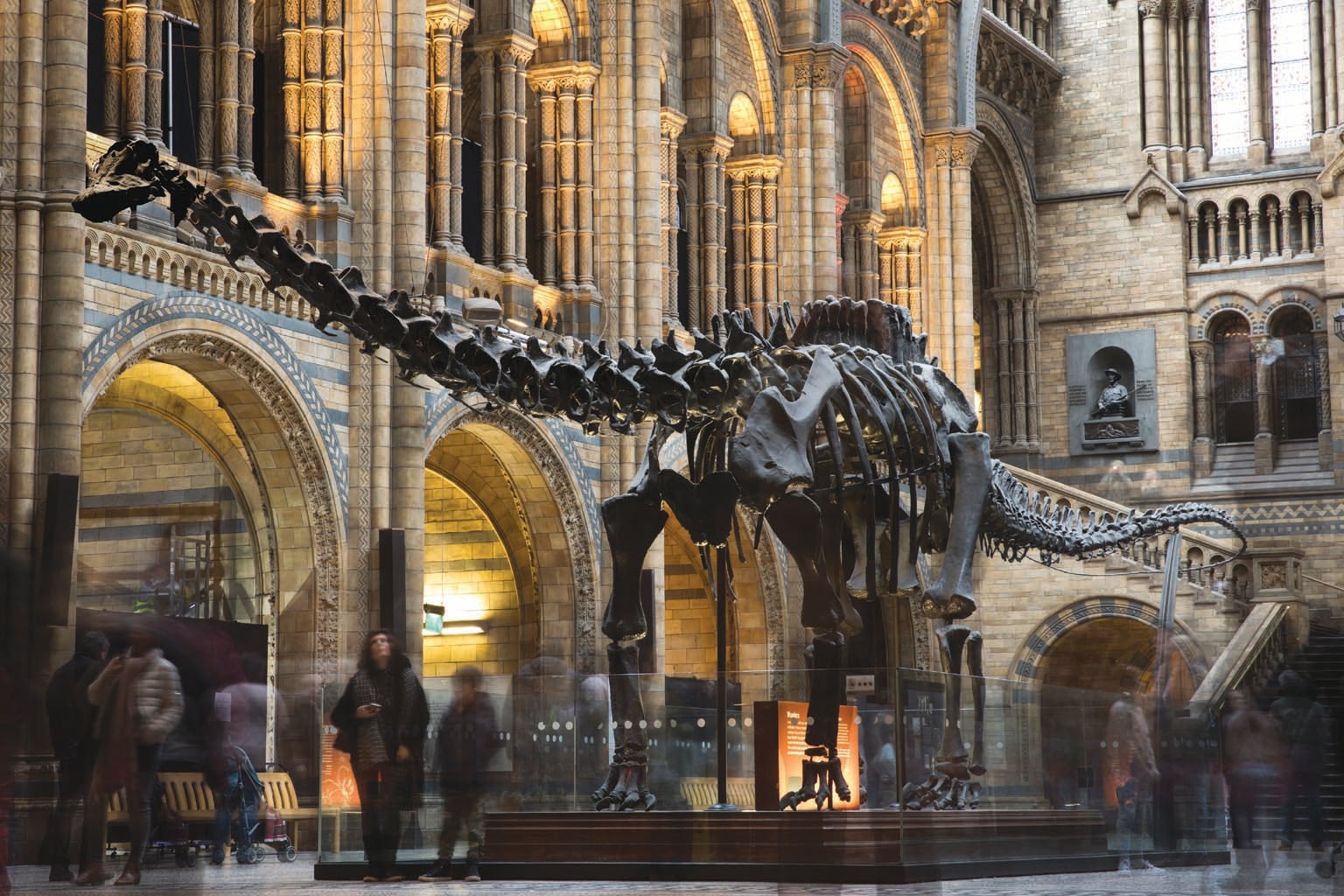
Sauropods also independently evolved a birdlike lung with air sacs throughout their bodies, making their breathing more efficient and their bodies lighter for their size. Many large sauropods were upward of 10 percent air inside, overall.
Their long necks and small heads, lack of parental care, and air-filled bodies explain why sauropods are bigger than other land animals in general. But these traits don't explain why 36 lineages within the sauropod group surpassed the other lineages to attain truly epic proportions. Each case seems to have been distinct—predation pressure may have led to the evolution of increased growth rates in one instance, resource abundance could have allowed for extended growth seasons in another—and will require a lot more study to solve.
So much about sauropods is awe-inspiring: they pushed the bounds of biological possibility not once but dozens of times. With an ever improving fossil record, we hope to soon understand some of the evolutionary pressures that led sauropods to become, over and over, the largest land animals of all time.
